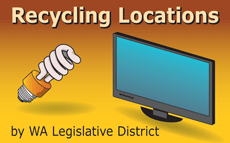
Electronics
The Problem: Volume, Toxicity, Cost, Waste
Rapid technological advances have shortened the useful life of computers, phones and other electronic devices to just a few short years. This encourages consumers to replace their computer systems, televisions, phones, gaming devices and other equipment more and more frequently. Consumers need a cost-effective and sustainable way to manage their unwanted electronic products that will protect public health and the environment.
Volume: According to the EPA (PDF), Americans generated about 3,190,000 tons of consumer electronics in the U.S. in 2009. Of that, only 600,000 tons were recovered while 2,590,000 were discarded. In 2011, flat panel TV shipments grew 1% to 39.1 million units from 38.6 million units in 2010, although that amount may be falling off in coming years. The use of smart phones has also boomed, which means the number of obsolete cell phones is also growing.
Toxicity: Second only to vehicle batteries, glass picture tubes (cathode ray tubes or CRTs) in computer monitors and TVs are the single largest source of lead in the waste stream. Liquid crystal flat panel displays contain mercury. Circuit boards also contain lead, chromium, and other hazardous materials. Municipal landfills and incinerators are not designed to handle large quantities of these materials.
Cost: Computers, TVs, smart phones and other electronic devices were designed with little or no thought to recycling and are difficult to disassemble. Recovering the high-value recyclable materials and the toxic components from these discarded devices is costly due to the amount of labor or expensive equipment required to separate out the recyclable materials.
Wasted Resources: Electronic equipment contains valuable resources that should be recycled. Used computers and electronic devices can be repaired and re-used by others if they make their way back into the market soon enough. If the equipment is broken, it can be disassembled into recyclable commodities including glass, plastic and metals that can be reprocessed into other consumer products.
Product Stewardship Solutions
Product stewardship solutions include activities that manufacturers as well as retailers, governments and consumers can take to minimize the environmental impact of the product throughout all stages of the products' life cycle, including end of life management.
Take Back Programs: Manufacturers, retailers and other organizations can provide and finance take back programs to collect unwanted electronic products from consumers. Many manufacturers such as Dell and HP offer take back programs for their products. Retailers like Staples and Best Buy also offer recycling options for certain electronic products including computers and cell phones.
Legislation: There are currently 25 states in the U.S. that have product stewardship legislation in place for electronic products. The legislation has many variations, the most common requires that the electronic product manufacturers finance and provide a statewide program to take back unwanted electronic equipment from consumers. There is no fee charged when the product is taken in for recycling, rather it is included in the price of the product or is charged when the product is purchased. The manufacturer, usually through a stewardship organization, is responsible for meeting specific performance goals such as providing convenient, accessible collection locations throughout the state. Local and state governments help to publicize the program while retailers and consumers take an active role in ensuring that the equipment is properly recycled.
Design: Manufacturers can redesign products to use fewer harmful substances, to be more durable, reuseable and recyclable, and made from recycled materials. For example, toxic components can be substituted with non-toxic materials; a single plastic resin could be used and labeled so that can be easily identified and processed; or the product could be designed with a minimal amount of fasteners so it can be taken apart without special tools.
